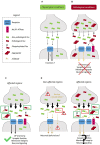Tau Secretion: Good and Bad for Neurons
- PMID: 31293374
- PMCID: PMC6606725
- DOI: 10.3389/fnins.2019.00649
Tau Secretion: Good and Bad for Neurons
Abstract
In Alzheimer's disease (AD), neurofibrillary tangles (NFTs), lesions composed of hyperphosphorylated and aggregated tau, spread from the transentorhinal cortex to the hippocampal formation and neocortex. Growing evidence indicates that tau pathology propagates trans-synaptically, implying that pathological tau released by pre-synaptic neurons is taken up by post-synaptic neurons where it accumulates and aggregates. Observations such as the presence of tau in the cerebrospinal fluid (CSF) from control individuals and in the CSF of transgenic mice overexpressing human tau before the detection of neuronal death indicate that tau can be secreted by neurons. The increase of tau in the CSF in pathological conditions such as AD suggests that tau secretion is enhanced and/or other secretory pathways take place when neuronal function is compromised. In physiological conditions, extracellular tau could exert beneficial effects as observed for other cytosolic proteins also released in the extracellular space. In such a case, blocking tau secretion could have negative effects on neurons unless the mechanism of tau secretion are different in physiological and pathological conditions allowing the prevention of pathological tau secretion without affecting the secretion of physiological tau. Furthermore, distinct extracellular tau species could be secreted in physiological and pathological conditions, species having the capacity to induce tau pathology being only secreted in the latter condition. In the present review, we will focus on the mechanisms and function of tau secretion in both physiological and pathological conditions and how this information can help to elaborate an efficient therapeutic strategy to prevent tau pathology and its propagation.
Keywords: extracellular tau; propagation; secretion; tau protein; tauopathies.
Figures


Similar articles
-
Novel drugs affecting tau behavior in the treatment of Alzheimer's disease and tauopathies.Curr Alzheimer Res. 2011 Sep;8(6):678-85. doi: 10.2174/156720511796717122. Curr Alzheimer Res. 2011. PMID: 21605038 Review.
-
Propagation of tau pathology in Alzheimer's disease: identification of novel therapeutic targets.Alzheimers Res Ther. 2013 Oct 23;5(5):49. doi: 10.1186/alzrt214. eCollection 2013. Alzheimers Res Ther. 2013. PMID: 24152385 Free PMC article. Review.
-
Autophagy-Mediated Secretory Pathway is Responsible for Both Normal and Pathological Tau in Neurons.J Alzheimers Dis. 2019;70(3):667-680. doi: 10.3233/JAD-190180. J Alzheimers Dis. 2019. PMID: 31256134
-
Non-tau based neuronal degeneration in Alzheimer's disease -- an immunocytochemical and quantitative study in the supragranular layers of the middle temporal neocortex.Brain Res. 2008 Jun 5;1213:152-65. doi: 10.1016/j.brainres.2008.03.043. Epub 2008 Apr 1. Brain Res. 2008. PMID: 18455153
-
Tau Secretion.Adv Exp Med Biol. 2019;1184:123-134. doi: 10.1007/978-981-32-9358-8_11. Adv Exp Med Biol. 2019. PMID: 32096034 Review.
Cited by
-
Distinct Neurotoxic Effects of Extracellular Tau Species in Primary Neuronal-Glial Cultures.Mol Neurobiol. 2021 Feb;58(2):658-667. doi: 10.1007/s12035-020-02150-7. Epub 2020 Oct 1. Mol Neurobiol. 2021. PMID: 33001416
-
Tau Protein Modulates Perineuronal Extracellular Matrix Expression in the TauP301L-acan Mouse Model.Biomolecules. 2022 Mar 26;12(4):505. doi: 10.3390/biom12040505. Biomolecules. 2022. PMID: 35454094 Free PMC article.
-
Human Tau Isoforms and Proteolysis for Production of Toxic Tau Fragments in Neurodegeneration.Front Neurosci. 2021 Oct 21;15:702788. doi: 10.3389/fnins.2021.702788. eCollection 2021. Front Neurosci. 2021. PMID: 34744602 Free PMC article. Review.
-
The Relationships Among Metal Homeostasis, Mitochondria, and Locus Coeruleus in Psychiatric and Neurodegenerative Disorders: Potential Pathogenetic Mechanism and Therapeutic Implications.Cell Mol Neurobiol. 2023 Apr;43(3):963-989. doi: 10.1007/s10571-022-01234-3. Epub 2022 May 30. Cell Mol Neurobiol. 2023. PMID: 35635600 Free PMC article. Review.
-
Tau oligomer induced HMGB1 release contributes to cellular senescence and neuropathology linked to Alzheimer's disease and frontotemporal dementia.Cell Rep. 2021 Jul 20;36(3):109419. doi: 10.1016/j.celrep.2021.109419. Cell Rep. 2021. PMID: 34289368 Free PMC article.
References
-
- Barthelemy N. R., Gabelle A., Hirtz C., Fenaille F., Sergeant N., Schraen-Maschke S., et al. (2016). Differential mass spectrometry profiles of tau protein in the cerebrospinal fluid of patients with Alzheimer’s disease, progressive supranuclear palsy, and dementia with lewy bodies. J. Alzheimers Dis. 51 1033–1043. 10.3233/jad-150962 - DOI - PubMed
Publication types
LinkOut - more resources
Full Text Sources
Research Materials

